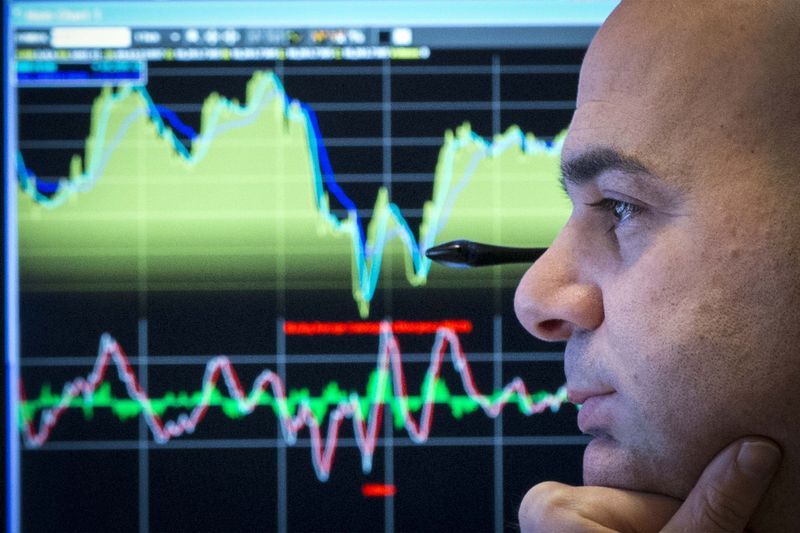Intel stock extends gains after report of possible U.S. government stake
* Graphic: World FX rates in 2019 http://tmsnrt.rs/2egbfVh
* MSCI All Country World Index down 0.1%
* Dollar steadies close to two-year highs
* British PM Johnson to unveil final Brexit offer
By Ritvik Carvalho
LONDON, Oct 2 (Reuters) - A major global share index hit its
lowest level in a month on Wednesday after U.S. manufacturing
activity tumbled to more than a decade low, sparking worries
that the fallout from the U.S.-China trade war is spreading to
the U.S. economy.
The dollar .DXY steadied, having earlier been knocked off
its highest levels in more than two years following the data.
The index that measures the greenback against a basket of peers
was up 0.16%.
A slowdown in U.S. economic growth would remove one of the
few remaining bright spots in the global economy and come just
as Europe is seen as close to falling into recession.
MSCI's gauge of stocks across the globe .MIWD00000PUS ,
covering 49 markets, dipped 0.3% to its lowest since Sept. 5,
after shedding 0.83% in the previous session.
European shares opened lower, with London stocks lagging the
most on fresh Brexit drama. The pan-European STOXX 600 index was
down almost 1 percent. .EU
The FTSE 100 index .FTSE slipped 1.5%, the largest drop
across European regions and ahead of UK Prime Minister Boris
Johnson's talks with Brussels as he prepares to announce his
final Brexit offer. The pound was down 0.6% at $1.2238. GBP=D3 GBP/
Adding to investor anxieties, European companies looked set
for their worst quarterly earnings in three years as revenue
drops for the first time since early 2018, according to the
latest Refinitiv data. In Asia, MSCI's ex-Japan Asia-Pacific shares index
.MIAPJ0000PUS dropped 0.8%, with Australian shares .AXJO
falling 1.5% and South Korean shares shedding 1.95%. Japan's
Nikkei .N225 slid 0.5%. China markets are closed for a
one-week holiday.
"Our base case is that trade tensions will remain elevated,
and we expect global growth to slow in 2020 to its slowest pace
since the global financial crisis," said Mark Haefele, chief
investment officer at UBS Global Wealth Management.
"We don't rule out a worsening of the trade situation over
the next six to 12 months."
Hong Kong's Hang Seng index .HSI was down 0.3% after a
market holiday the previous day. The index fell as much as 1.2%
in early trade. On Tuesday, Hong Kong police shot a teenage
protester, the first to be hit by live ammunition in almost four
months of unrest in the Chinese-ruled city. Adding to tensions in Asia, North Korea carried out at least
one more projectile launch on Wednesday, a day after it
announced it will hold working-level talks with the United
States at the weekend. On Wall Street on Tuesday, the S&P 500 .SPX lost 1.23% to
hit four-week lows. Selling was triggered after the Institute
for Supply Management's (ISM) index of factory activity, one of
the most closely watched data on U.S. manufacturing, dropped to
the lowest level since June 2009. Markets had been expecting the index to rise back above the
50.0 mark denoting growth.
"Historically, equity returns are worst when the ISM
manufacturing drops from levels below the 50 threshold," Patrik
Lang, head of equity research at Julius Baer.
"Uncertainty around the US-China trade war is obviously the
main reason for the weakness, with companies exposed to global
trade increasingly putting off investment decisions."
The data came after euro zone manufacturing data showed the
sharpest contraction in almost seven years. The poor data lifted the Fed funds rate futures price
sharply, with the November contract FFX9 now pricing in about
an 80% chance the U.S. Federal Reserve will cut interest rates
on Oct. 30, compared to just over 50% before the data.
U.S. President Donald Trump once again lashed out at the
Federal Reserve on Tuesday, saying the central bank has kept
interest rates "too high" and that a strong dollar is hurting
U.S. factories. It is another question, however, whether the Fed will cut
interest rates as hastily as Trump, and financial markets, want.
Just on Tuesday, Chicago Fed President Charles Evans said
the Fed can keep rates steady for now. Elsewhere in currencies, the yen rose to 107.71 yen per
dollar JPY= , from Tuesday's low of 108.47.
The euro fell 0.15% to $1.0915 EUR= .
The Australian dollar fetched $0.6693 AUD=D4 , having hit a
10-1/2-year low of $0.6672 the previous day after the Reserve
Bank of Australia cut interest rates and expressed concern about
job growth.
Euro zone bond yields inched up after another speech from
outgoing ECB chief Mario Draghi calling for fiscal stimulus to
boost the region's sluggish economy. GVD/EUR
Gold rose to $1,479.13 per ounce XAU= from a two-month low
of $1,459.50 hit on Tuesday on the back of a robust U.S. dollar.
The weak U.S. data pushed oil prices to near one-month lows,
although a surprise drop in U.S. crude inventories helped them
to rebound. O/R
Brent crude LCOc1 futures rose 0.2% to $59.01 a barrel,
after hitting a four-week low of $58.41 on Tuesday, while U.S.
West Texas Intermediate (WTI) crude CLc1 gained 0.69% to
$53.99 per barrel after hitting a one-month low of $53.05.
U.S. manufacturing https://tmsnrt.rs/2pcL2gs
^^^^^^^^^^^^^^^^^^^^^^^^^^^^^^^^^^^^^^^^^^^^^^^^^^^^^^^^^^^>
